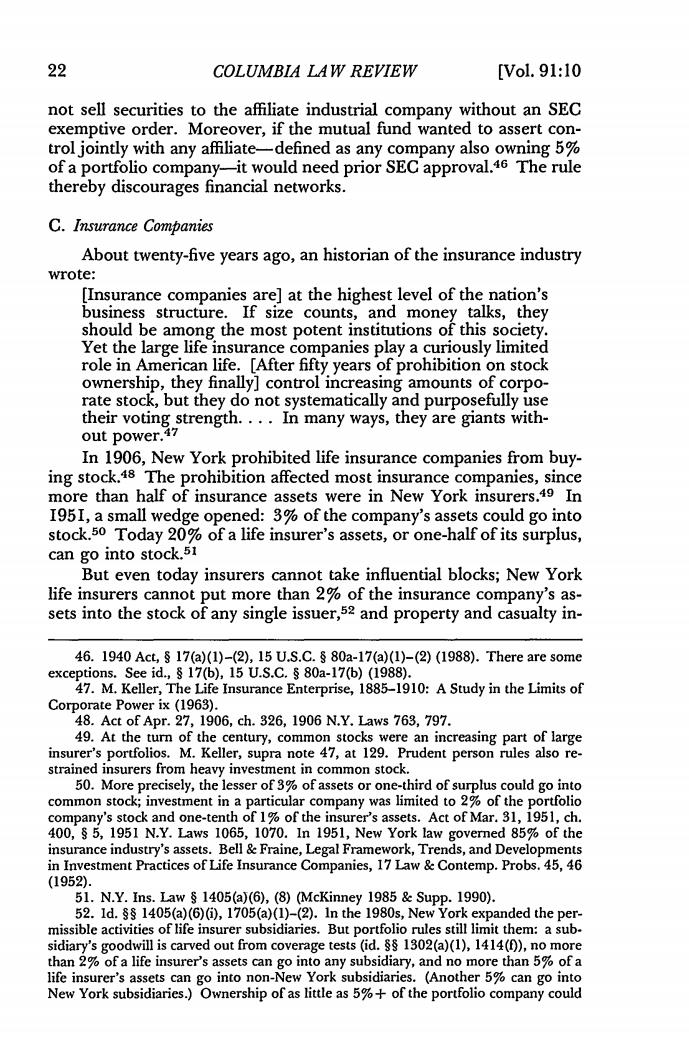正在加载图片...

22 COLUMBIA LAW REVIEW [Vol.91:l0 not sell securities to the affiliate industrial company without an SEC exemptive order.Moreover,if the mutual fund wanted to assert con- trol jointly with any affiliate of a portfolio company- would ne ral.46 The rule thereby discourages financial networks. C.Insurance Companies About twenty-five years ago,an historian of the insurance industry wrote [Insurance companies are]at the highest level of the nation's business structure.If size counts,and money talks,they should be among the most potent institutions of this society. Yet the large life insurance companies play a curiously limited role in American life.[After fifty years of prohibition on stock ownership,they finally]control increasing amounts of corpo rate stock,but they do not systematically and purposefully use their voting strength.In many ways,they are giants with- out power. In 1906.New York prohibited life insurance companiesfrom buy- n affected most ins uranc mpanies, more than half of insurance assets In I95I,a small wedge opened:3%of the company's assets could go into stock.50 Today 20%of a life insurer's assets,or one-half of its surplus, can go into stock 5 But even today insurers cannot take influential blocks;New York life insurers cannot put more than 2%of the insurance company's as- sets into the stock of any single issuer,52 and property and casualty in- ,80 -17(a)(1)-(2)(1988).There are some 10:AStudy in the Limits of erprise Corporate powe rix(1963) 48.Act of Apr.27,1906,ch.326,1906N.Y.Laws763,797. 49.At the turn of the century.common stock were an increasing part of large insurer's portfo supra note 47,at 12 Prudent person rules also re- 50.Mo rs third of s could go into common stock:investment in a particular company was limited to 2%of the rtfolio s.Act of Mar.31,1951,ch. 1070.In 1951,New Yor law gover 85%of the stry ices of Life In ega o6P4546 (1952). 51.N.Y.Ins.Law 1405(a)(6),(8)(McKinney 1985 Supp.1990). dia ,1705(a)(1)-(2).In the 1980s,New York expandedth of life ins 6d.891302a1,14140) s can ro into any subsidiary.and no more than5 of life insurer's assets can go into non-New York subsidiaries.(Another 5%can go into New York subsidiaries.Ownership of as little as 5%+of the portfolio company couldCOLUMBIA LAW REVIEW not sell securities to the affiliate industrial company without an SEC exemptive order. Moreover, if the mutual fund wanted to assert controljointly with any affiliate- defined as any company also owning 5% of a portfolio company-it would need prior SEC approval. 46 The rule thereby discourages financial networks. C. Insurance Companies About twenty-five years ago, an historian of the insurance industry wrote: [Insurance companies are] at the highest level of the nation's business structure. If size counts, and money talks, they should be among the most potent institutions of this society. Yet the large life insurance companies play a curiously limited role in American life. [After fifty years of prohibition on stock ownership, they finally] control increasing amounts of corporate stock, but they do not systematically and purposefully use their voting strength . In many ways, they are giants without power. 47 In 1906, New York prohibited life insurance companies from buying stock.48 The prohibition affected most insurance companies, since more than half of insurance assets were in New York insurers. 49 In 1951, a small wedge opened: 3% of the company's assets could go into stock. 50 Today 207 of a life insurer's assets, or one-half of its surplus, can go into stock.51 But even today insurers cannot take influential blocks; New York life insurers cannot put more than 2% of the insurance company's assets into the stock of any single issuer,5 2 and property and casualty in- 46. 1940 Act, § 17(a)(1)-(2), 15 U.S.C. § 80a-17(a)(1)-(2) (1988). There are some exceptions. See id., § 17(b), 15 U.S.C. § 80a-17(b) (1988). 47. M. Keller, The Life Insurance Enterprise, 1885-1910: A Study in the Limits of Corporate Power ix (1963). 48. Act of Apr. 27, 1906, ch. 326, 1906 N.Y. Laws 763, 797. 49. At the turn of the century, common stocks were an increasing part of large insurer's portfolios. M. Keller, supra note 47, at 129. Prudent person rules also restrained insurers from heavy investment in common stock. 50. More precisely, the lesser of 3% of assets or one-third of surplus could go into common stock; investment in a particular company was limited to 2% of the portfolio company's stock and one-tenth of 17o of the insurer's assets. Act of Mar. 31, 1951, ch. 400, § 5, 1951 N.Y. Laws 1065, 1070. In 1951, New York law governed 85%o of the insurance industry's assets. Bell & Fraine, Legal Framework, Trends, and Developments in Investment Practices of Life Insurance Companies, 17 Law & Contemp. Probs. 45, 46 (1952). 51. N.Y. Ins. Law § 1405(a)(6), (8) (McKinney 1985 & Supp. 1990). 52. Id. §§ 1405(a)(6)(i), 1705(a)(1)-(2). In the 1980s, New York expanded the permissible activities of life insurer subsidiaries. But portfolio rules still limit them: a subsidiary's goodwill is carved out from coverage tests (id. §§ 1302(a)(1), 1414()), no more than 2%o of a life insurer's assets can go into any subsidiary, and no more than 5% of a life insurer's assets can go into non-New York subsidiaries. (Another 5% can go into New York subsidiaries.) Ownership of as little as 5% + of the portfolio company could [Vol. 91:10